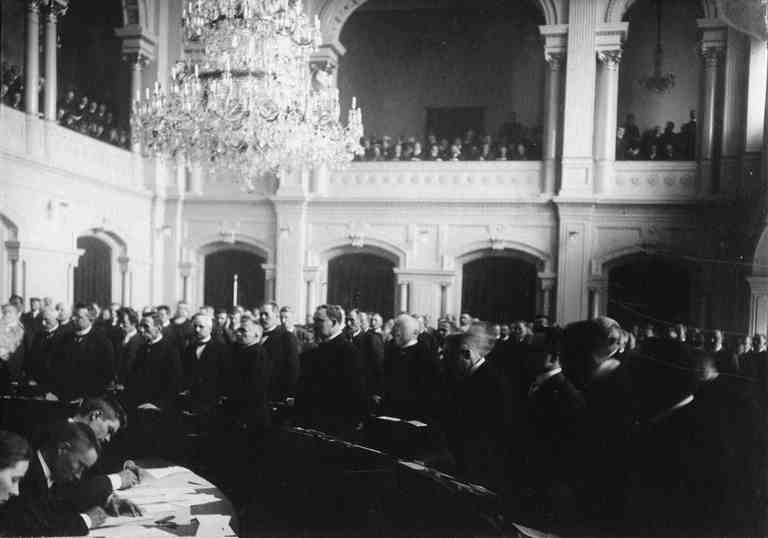Continuity is the most important feature of Finnish democracy in international comparison. The modern parliamentary system dates back to 1863 when the Diet of Finland with the four Estates started to convene. Democratic legislative procedures and the party system evolved, even though the Russian Emperor ultimately made the decisions autocratically.
In 1907, the congress was replaced by a 200-seat unicameral parliament, with representatives elected in universal elections. In the first elections, 19 women MPs were elected. Since then, the parliament, almost unchanged, has remained the foundation of Finnish democracy.
The Diet of Finland started to convene in 1863
In 1362, Finns, living in the eastern provinces of Sweden, were granted the right to participate in the elections for the king of Sweden. The Finns would send a lawspeaker, priests and twelve peasants as their representatives to the Stones of Mora. From then on, the Finns participated in the Swedish parliament until the eastern provinces were annexed to Russia in 1809 and formed the autonomous Grand Duchy of Finland.
The Diet of Porvoo, with four Estates, assembled once in 1809 but, after that, the Emperor did not call the Diet to convene for half a century. Finland enjoyed a high degree of autonomy and was governed by the Emperor’s decisions prepared by the Finnish civil service without the contribution of the Diet.
In 1863, the Emperor of Russia and Grand Duke of Finland, Alexander II, summoned the Finnish legislative council to form a national assembly. The country was in need of several major reforms that required more statutory tax reserves for which the approval of the Estates was required.
The Emperor opened the session of the four Estates on 18 September 1863 at the Imperial Palace in Helsinki, which later became independent Finland’s Presidential Palace. The four Estates were the nobility, clergy, burghers and peasants. Each of the Estates convened separately at the House of Nobility, which had been completed a year earlier.
The legislative committees had representatives from all the Estates, and since Swedish was the official language of the assembly, interpreters’ services were required on a regular basis. Only a few of the representatives knew both Swedish and Finnish. The most important legal reform was the law on municipal sovereignty, which came into force in 1865 and separated the church and the secular administration, creating the foundation for the modern Finnish municipal democracy.
The Estates convened at the Emperor’s invitation every three to six years for a few months to prepare legislation. The parliamentary procedures with Speakers and Committees evolved during this time and continued along the same lines during the unicameral parliament.
Parliamentary reform in 1907
Due to the Russo-Japanese war and internal pressures, the Emperor consented to political reforms that extended to Finland as well. In 1905, the liberal Swedish professor Leo Mechelin formed the first political government, or Senate, in Finland, which prepared a radical parliamentary reform.
The Estates approved and the Emperor ratified the new parliamentary order in 1906. The Diet with the four Estates was replaced by a parliament to be elected with universal suffrage. Elections were to be carried out according to the D’Hondt proportional method, applied on a per constituency basis, so that seats in the parliament would be allocated approximately in proportion to the relative share of the votes received by each party. This same proportional electoral system is still in use in Finland both in parliamentary and local (municipal) elections.
All persons of 24 years of age or older were eligible to vote. That included women as well, for the first time in the world. The first parliament had 19 women representatives from different parties.
Emergence of political parties
The political organisation began with language parties. The so-called Fennomans, who advocated for the rights of the Finnish-speaking majority, were the first to become organised. They eventually became the Finnish Party. As a legacy of the Swedish rule, the language of administration and education in Finland was Swedish, although only 15 per cent of the population spoke Swedish as their mother tongue in 1815. The Svecoman movement arose as a reaction to the Fennoman movement to defend the privileges of the Swedish-speaking population. The Svecoman movement later became the Swedish Party.
The liberal and constitutional wing of the Finnish Party broke away from the party in the early 1900s and formed the Young Finnish Party. Constitutionalism involved more resolute resistance to Russification measures and stressed the sacrosanctity of the laws, whereas the Finnish Party believed in a more pragmatic negotiating strategy to protect the position of the Finnish language. Later, a group called the Agrarian League split from the Young Finnish Party to promote the interests of the agrarian population.
The Workers’ Movement evolved into the Social Democratic Party in 1899. It became the largest party in the unicameral parliament with 80 seats out of 200 in the 1907 elections. The SDP split up when the Communist Party of Finland (SKP) was founded in Moscow in 1918 after the failed rebellion. The SKP was banned from the 1920s to the 1940s but once allowed again after the Second World War it became a major political force until the late 1980s.
In 1918, the Finnish Party and the Young Finnish Party became, respectively, the National Coalition Party (Kokoomus) and National Progressive Party (Kansallinen edistyspuolue). The former continues today, but the latter, after many name changes, has disappeared from the Finnish political scene.
The Finnish party system is very stable: although the parties periodically break up into factions, the only truly new party is the Green League born in the 1980s.

